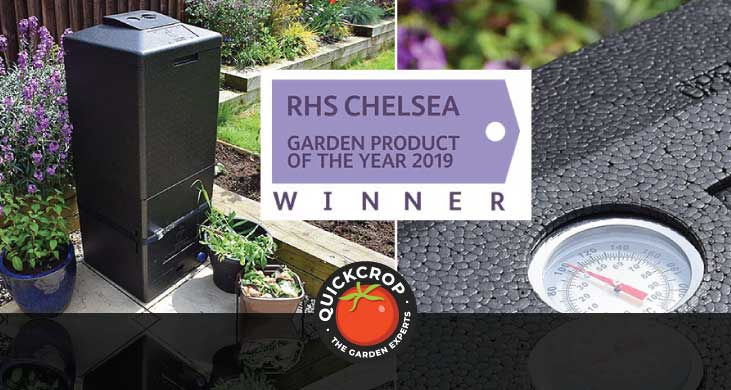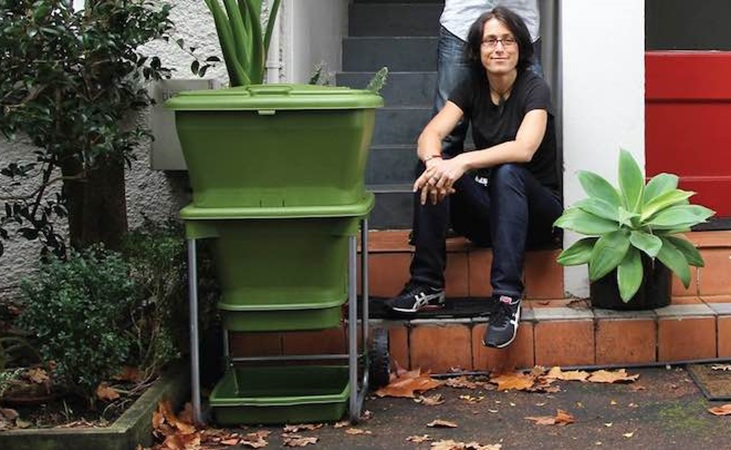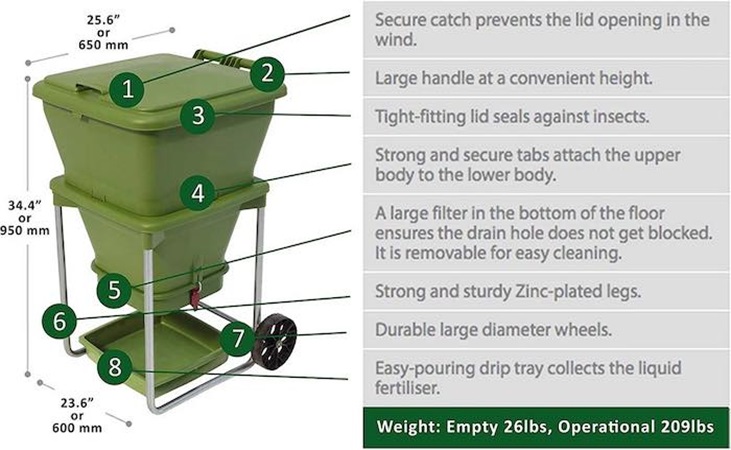Hungry Bin vs Hotbin (Composter Comparison)

Home composting is a fantastic way of killing two birds with one stone. You can process garden and kitchen waste (and reduce your bin collection costs) while at the same time producing your own crumbly, nutritious soil improver. As a bonus you can feel better about your carbon footprint, as methane-producing waste is diverted from landfill.
Two popular composters we supply are the ‘Hungry Bin’ and the ‘Hotbin’. These are both great solutions for the average-sized household, with some key differences. First though, some common similarities and benefits:
- They allow for year-round composting
- They are relatively low-maintenance, with no need for turning or manual aerating
- They efficiently process waste, producing a rich compost for your garden
- They will also produce a liquid fertiliser as a byproduct of the composting process
- The enclosed nature of these units means no problems with smell or rodents

The Hungry Bin composter
The hungry bin is a form of worm composting or ‘vermicomposting’. This is where worms (usually red wrigglers that you can purchase from your friendly garden suppliers) break down the waste material. While other composting methods rely on heat or mass of material, worm composting is more efficient working with smaller volumes of waste. It’s also an odour-free method.
Designed in New Zealand, The Hungry Bin is made from a tough food-grade UV resistant plastic. The bin’s conical shape is key to how the clever system works. Worms - being surface feeders - will ‘live’ in the widest top section of the hungry bin, consuming and breaking down the waste.

Composting Worms 500g-2kg
View ProductAs the resulting compost moves down through the bin, the conical shape compresses it as it goes, so that when you remove it from the hatch at the bottom it doesn’t make a mess.
Maybe the most attractive feature of the Hungry Bin is the sheer quality of the compost produced: it’s extremely-nutrient rich and a perfectly balanced fertiliser for your vegetable garden. The reason we supply the Hungry Bin is that we feel it’s pretty much the only wormery composter that’s going to be large enough to adequately deal with waste from your average household - as opposed to being more of a hobby kit.

Hungry Bin Worm Composter
View ProductThe Hungry Bin is self-draining and has a drip tray underneath: this shouldn’t be ignored, because from here you get a liquid fertiliser as a kind of byproduct of the composting process. It's a really excellent nutrient-rich feed known as ‘worm tea’ or ‘compost tea’.
Just like a wheelie bin, the Hungry bin can handily be moved around on its sturdy wheels: you can even move it when it’s full of compost. The unit can process about 2kg of food waste a day, so will work for your average family of 4 - dealing with your vegetable garden waste as well as kitchen waste.
You can put cooked food in the bin, but avoid putting any meat, fish, dairy or fats in it. A great advantage of the Hungry Bin is that the worm population will ‘self-regulate’ in balance with available food, meaning that you won’t feel pressured to keep pumping material into the composter.

One more advantage of the Hungry Bin is that you won’t need to separate worms from the worm castings: this is because the worms tend to stick to the upper section of the composter.
To sum up, the Hungry Bin is really well-made and designed to last a long time. It’s very easy to use once you get the hang of it, and it's one we would highly recommend for keen gardeners due to the nutrient-rich compost that it produces.
The Hotbin Composter (Mark II)
The Hotbin Mk 2’s functional design and compact size means that it’s handy for using in small spaces - indeed it can slot unobtrusively alongside your wheelie bin.
The Hotbin is made from expanded polypropylene, which insulates the contents of the bin and allows it to reach temperatures of about 60°C and above. In turn this speeds up the composting process. In a best case scenario with your hot bin you can get finished compost in 30 days: that’s considerably faster than your standard ‘cold’ composter dealing with similar amounts of waste.
The high heat means that the Hotbin can be used throughout the winter, and it has the advantage of killing any weed seeds - which can be something of a problem with traditional compost piles. High temperatures also allow us to put in a wider range of materials - including (yes) meat, fish or fats from the kitchen. A built-in carbon filter will absorb smells from the composting process.

Hotbin Composter - 200 litres
View ProductThe Hotbin is really easy to use: you open the lid on top and add your garden and kitchen waste. The lower panel at the front can be removed to empty compost from the bin. Additionally, a little blue cap at the base is used to empty any liquid that the bin might produce. This can then be used as a liquid fertiliser.
You can check the temperature with a temperature gauge on the top, and adjust it by opening or closing a built-in lid valve. Every Hotbin also comes with an extra thermometer, which can be used to check the core temperature of the compost: simply open the lid and poke it into the compost inside.

Like any composting solution, the mix of material you put in the hot bin is going to be important. We find these work best with a mix of about 50% garden or kitchen waste and then 50% shredded paper or cardboard etc. Because it’s enclosed, it’s also important to keep air spaces in the mix. Each Hotbin comes with a bag of bulking agent (essentially bark mulch): this is layered within the material in the Hotbin, creating vital air pockets.
The Hotbin previously came in two sizes: the 200 litre model or the smaller 'mini hotbin', which is 100 litres. Size can be deceptive here though: the 200l unit might seem small compared to other composting units on the market, but because of the high-speed composting capability, it will actually end up processing about the same amount of material in a given year. The larger Hotbin will most likely suit a family of four, while the mini Hotbin may be suitable for a household of 1-2 or those with a small garden space.

Hotbin Mini Compost Bin (100 litre)
View ProductThe range was recently expanded to include the 'Mega Hotbin', which is suitable for allotments or large gardens with a sizeable amount of organic waste. This is a modular design with two sizes, with a 450 litre and 700 litre capacity respectively. The former can be expanded to the larger size with the aid of an expansion kit that is also available.
Which Is Best?
Directly comparing the two, the Hotbin will give you faster results: it promises rich compost in just 30-90 days, whereas the Hungry Bin system is a steadier organic process that doesn’t create the same levels of heat. The Hungry Bin process can take 3-4 months by comparison, and it requires a bit of patience at the beginning as you wait for the worm population to build up. You also should also be careful not to overfeed the Hungry Bin with too much material in one go.

The Hotbin has one clear advantage in the sense that you can feed it with cooked kitchen scraps such as chicken, fish etc that are verboten in a traditional compost pile. Meat and dairy products are not recommended for the Hungry Bin.
The Hungry Bin may be a better option if you have more sporadic amounts of kitchen and garden waste: this is because it is something of a self-regulating system where the worms will adapt to whatever amount of waste they are being ‘fed’. On the other hand, to keep the Hotbin at optimum temperatures you need to be keeping it fed with a certain level of waste. Then again, this might not be an issue at all if you’re an active gardener with a family of four.

A Guide to Making Homemade Compost
View Related ArticleThe Hotbin is by no means an unwieldy piece of equipment, but the Hungry Bin probably trumps it in portability. The wheels make it easy to move even when it’s full, whereas the Hotbin might be more awkward to move at the same stage.
When it comes to the Hungry Bin, there’s also an extra element of fun and intrigue as your worm population grows and starts working their way through the organic waste. As well as being an example of sustainability in action, it's kind of a microcosm of the natural earth-based life cycle.

Worm composting (or vermicomposting) has plenty of enthusiasts who swear by the ultra-nutritious qualities of the resulting compost or soil improver. Vermicompost is also well-regarded for its moisture-retaining ability when added to soil. Having said that, 'hot composting' - and its finished product - is no slouch on these fronts either.
Your mileage may vary when it comes to worms - they may indeed make you queasy, and that’s fine too! Economically speaking the worms are also going to add up to an extra expense initially. Overall though, whichever choice you make is bound to bring some fresh impetus to your composting efforts!




